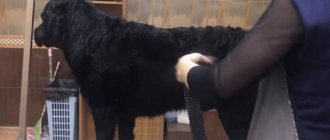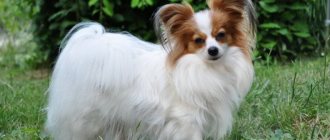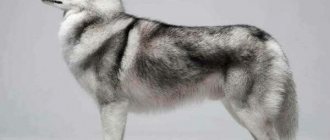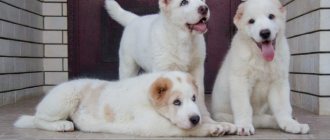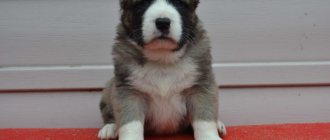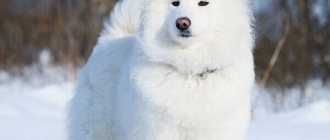Let's get acquainted with one of the largest dog breeds - the St. Bernard. Let's talk about the growth and development of puppies, and figure out how much a St. Bernard weighs at different periods of life. The most interesting indicators are observed during the active growth of puppies from a month to a year. The most active period of growth for a puppy at the withers is from 1 to 7 months, then the dog begins to gain size and weight, which in turn slows down its height growth slightly. A representative of the Saint Bernard breed gains its final height and weight by the age of 2.5 – 3 years.
The article shows the height and weight indicators that were obtained by me in the process of breeding St. Bernards!
Good-natured giant
When you look at photos of St. Bernard puppies, you simply can’t believe that these little charming fluffy balls will soon grow into real giants. The weight of an adult dog reaches one hundred kilograms! A kind of champion of his breed was Benedictine Jr. Hof, who weighed 140.6 kg. These huge dogs are surprisingly agile for their weight, although, in fairness, it is worth noting that St. Bernards do not particularly like to jump, they prefer to just run. Representatives of this breed are incredibly strong and resilient.
By the way, the record for the maximum weight moved by a dog belongs to a St. Bernard named Brandy Bear. With its own weight of 80 kg, it coped with railway rails weighing 2905 kg!
The slightly sad look of a St. Bernard, whether it is a puppy or an adult dog, has become a trademark of the good-natured rescuer. For these devoted friends, caring for a person has become the main meaning of life for several hundred years. Calm and obedient, complete absence of aggression - with his entire appearance the giant inspires favor and complete trust.
A powerful and generous gentleman will endure any mischief from your children; St. Bernards are very fond of having fun with children. Adoring and idolizing his master, the dog is distrustful of strangers, which makes him suitable for guard duty. You won’t hear your pet’s voice in vain; it is calm and silent.
Barking means only one thing - something is wrong and the owner’s intervention is required. This huge rescuer really likes to live in a family, to be part of it, a full-fledged member. He will be happy to take care of children and protect adults. From prolonged loneliness and separation from loved ones, the St. Bernard can become depressed and refuse to eat.
This giant's love for humanity is boundless and selfless. The good-natured dog gets along with other dogs and animals nearby without any problems, he simply exudes calm power. Considering how quickly St. Bernard puppies grow, training is recommended from an early age. Good manners and decent behavior for a pet of this weight and size are very important. Agree, a hundred-kilogram pet, putting its front paws on your shoulders and happily licking its owner’s nose, is not a test for everyone. On the other hand, the St. Bernard’s own heaviness, the puppy will finally form a strong skeleton only by the age of one and a half years, does not allow it to be used for strong physical exertion until this age.
Features in the development of St. Bernards from a month to a year
The height and weight of the pet depends on the origin of the dog; as a rule, the selection of parent pairs has a special influence. Another important indicator that determines a dog’s weight is the boneiness index. Saint Bernards are dogs with a strong, rough constitution. And the girth of the pastern is one of the most important measurements, indicating the massiveness and weight of the St. Bernard.
To measure the height at the withers for a small puppy, a regular measuring tape is suitable; to measure the weight of the cub, you will need a steelyard and a bag. Next, the grown puppy can be weighed on a floor scale. Well, when the dog no longer fits on the home scales, warehouse scales will be needed. They can be found at the airport or at the market. It is convenient to measure height with a meter ruler or a stadiometer at a kennel club. If this is not possible, then use a construction tape measure. The girth of the metacarpus is measured with a soft measuring tape (above the fifth finger and below the wrist joint)
Age 1 month
The average height of a one-month-old St. Bernard puppy is about 25 centimeters at the withers and weight is 2,500 - 3 kg. Pastern girth 8-9 cm.
Upon reaching the age of one month, puppies begin to actively feed on their own. It is very important not to get carried away with fattening babies; you should maintain a balance in nutrition. St. Bernard puppies need the correct proportions of protein, trace elements and vitamins. Typically, at this age, small St. Bernards sleep most of the day. Very little time is allocated for food and games. This is due to the active growth of future giants.
Age 2 months
At 60 days of age, St. Bernard puppies double their one-month-old weight. The height of a 2-month-old St. Bernard puppy is usually 30-35 cm at the withers, and its weight is from six to 10 kilograms. Pastern girth 10-11 cm.
Age 3 months
By three months, the small St. Bernard grows in height a little less intensively. The height at the withers reaches 35-40 centimeters, weight from thirteen to twenty kilograms. Wrist girth 12-14 cm. During this period, the puppy’s body begins to prepare for changing teeth.
Age 4 months
At four months, the little St. Bernard continues to actively grow and gain weight. During this period, the puppy begins to change its milk teeth. Consequently, there is an additional need for the correct balance of nutrients, trace elements and vitamins.
Milk teeth, with proper growth and development of a St. Bernard puppy, begin to change after the puppy reaches the age of four and a half months.
At the age of four months, the average growth of a puppy is 40-50 centimeters at the withers, weight is 17-35 kilograms or more. The girth of the pastern is 13-15 cm. By this time, the puppies become more active, move more, and play. If the puppy's genetic code is large in size, then both height and weight may vary significantly.
Age 5 months
At five months, intensive weight gain and growth continues. At 5 months, the puppy is 42-50 cm tall and weighs about 20-40 kilograms. The pastern girth is 14-15.5 cm. During this period, the animal should not be overfed, since excess weight can have a detrimental effect on the formation of the skeleton.
Age 6 months
A six-month-old puppy grows to 54-56 centimeters and gains an average of 35-42 kilograms of weight. Pastern girth 14.5-16 cm.
Age 7 months
At 7 months, a St. Bernard puppy is approaching adolescence. His height at the withers is 57-65 cm, and his weight is 35-46 kg. The girth of the pastern is 15.5-17 cm. It is important that the puppy is not too thick. If you run your hand over the chest, the ribs should be felt. Our task is to grow a healthy skeleton and musculoskeletal system until this moment.
Age 8 months
An eight-month-old puppy reaches the height described in the breed standard, that is, 65-70 cm at the withers. But its weight is only about 45-53 kilograms. Pastern girth 16.5-18 cm.
Further, depending on genetic predispositions, the development of the St. Bernard varies greatly. Some individuals continue to actively grow in height and continue to gain weight. Dogs of this type later complete their final formation.
Age 9 months
At nine months of age, the St. Bernard puppy continues to grow, but not as quickly as at a younger age. Further, the girth of the metacarpus increases slightly. Since by 9 months the skeleton is completely formed, which in turn slows down growth, while an active gain of muscle mass occurs. In this period of the dog’s life, the height is 68-75 cm at the withers with a weight of 45-52 kg.
Age 10 months
At ten months, the puppy's height reaches from 65 to 80 centimeters. The weight should accordingly begin to approach 50-67 kilograms.
Age 1 year
A one-year-old St. Bernard practically stops growing in height; the dog will continue to grow in width. The approximate height of the male is 80 cm and weight is about 70 kg. At this age, muscle mass gains, bone strengthening, and head formation continue.
By one and a half years, height growth finally ends. During this six-month period, the circumference of the pastern increases by 0.5-1 cm, height by 2-3 cm. For an adult dog of the St. Bernard breed, it is typical for the weight to approach the height at the withers. That is, if your St. Bernard has a height at the withers of 80 centimeters, then at the age of two years his weight should be at least 77 kilograms.
Slobbery Titan
Alpine rescue dogs, thanks to their dense, thick coat, thrive in any climate. The exception is, perhaps, very hot summers. In such weather, the “baby” drools, as they say, like a stream. True, before and after meals, they flow from the mountaineer, regardless of the time of year. Keep a napkin or small towel handy to wipe your client's face, unless, of course, you want to act as a blotter yourself.
Saint Bernards shed heavily twice a year. During seasonal shedding, it is necessary to comb the dog; this does not cause any special problems, since this breed’s hair does not mat and does not form tangles. The rest of the time, it is enough to comb your pet 1-2 times a week.
Bred in the snowy Alps, these good-natured dogs have coats that are superbly water-repellent. You should not overuse water procedures, so as not to wash away the natural fatty lubricant from the fur coat and skin of the mountain giant.
The St. Bernard puppy is a large breed, so you must clearly understand that this fluffy little thing will soon turn into a huge dog that needs plenty of space. Of course, there is plenty of evidence of how wonderful a pet feels in a city one-room apartment, but I would also like to hear the opinion of the owners who are forced to share a modest living space with this giant.
It is better to have a spacious yard in which there will be enough opportunities to find shade on a hot July afternoon. And if you decide to get a bitch, then keep in mind that a litter usually contains from two to twelve puppies.
A record number of babies was recorded in 1975 in the United States. Carefree Anne, a St. Bernard whose 23 puppies were born in that litter, became the undisputed champion.
Height and weight of St. Bernard at 3 years old
Saint Bernards reach full development and physical formation at the age of 2.5-3 years. The breed standard specifies the lower limits of height at the withers:
- - female at least 65 cm and weighing 58-63 kg.
- - male at least 70 cm and weighing 68-73 kg.
We are talking about a breed of giants, so there is no upper limit to the height of St. Bernards. Here the main criterion is harmonious addition. The dream of any breeder is to get a huge St. Bernard so that the height, weight and bones correspond to the breed standard, and at the same time cause delight from aesthetic pleasure.
Exterior of St. Bernard
The photo of the St. Bernard shows its recognizable features: a large body, and on a wide head - hanging round ears, a short muzzle and an upturned nose.
The tail is long without bends, the paws are powerful. The pet’s charming and sad look will not leave any person indifferent.
- The weight of a male of this color can reach 100 kg,
- And the average weight of a St. Bernard is 80 kg. The color is white with red spots.
The St. Bernard lives only 8-10 years.
Distinctive features
The main distinguishing characteristics of St. Bernards are:
- General form. The dog is huge, strong, resilient and heavy. With the same huge head, proportional to the body.
- Head. Large, like the body, heavy, damp. With a wide protruding forehead, strongly protruding cheekbones. The transition from the forehead to the nose is significantly pronounced.
- Lips. Thick, hanging, loose. The upper jowls cover the lower jaw. Pigmented black, pink markings possible.
- Muzzle. Wide, short, smooth. Does not expand from nose to forehead. The bridge of the nose is slightly turned up or straight. The nose is large, with wide nostrils, and pigmented black. Scissor or pincer bite. Teeth set – 42 pieces.
- Neck. Powerful, muscular, shortened. It has a pronounced, massive dewlap, but without going overboard. The transition from neck to back is significantly pronounced.
- Frame. The shoulder blades are wide, muscular, and set obliquely. The chest is wide, not drooping, with prominent ribs. The back is wide, powerful, without sagging. The loin is voluminous, the croup is very well developed. Powerful, strong, strong thighs. The stomach is slightly tucked in.
- Tail. The base of the tail is at the level of the waist - set high. Heavy, long, wider at the base than at the end. Lowered, except in a state of excitement.
- Limbs. Well developed, muscular, straight and strong. Strong arched fingers, slightly closed. The paws are large, powerful with well-developed muscles.
- Coat and color. The coat is very thick, medium hard, and fits well to the body. There is a dense undercoat. On the thighs and tail the hairs are longer and thicker, but without dewlap. Red color, spots from reddish-brown to yellow. A white tip of the tail, paws, chest, “collar” or spot on the neck is considered obligatory. A black mask with a white stripe on the forehead is permitted.
Possible diseases and methods of treating them
In general, the Saint Bernard is a dog in good health. But during the period of growth, that is, up to the age of one year, she is threatened by various diseases of the joints and bones. For example: dysplasia, herniated vertebral discs.
With age, overeating and low physical activity can lead to obesity. As a result - disease of the heart and blood vessels, gastrointestinal tract and other internal organs.
Damage to the nervous system, whether hereditary or viral, can lead to epilepsy. A balanced menu, proper grooming steps, and long walks will keep the dog’s health at a good level. And the owner will be given the friendship of a large and noble creature.
Choosing a puppy
When buying a puppy, you need to study the offers, visit well-known nurseries with a good reputation, and take the help of an experienced expert.
When choosing a dog, it is advisable to determine the purpose for which the animal is purchased - participation in competitions, exhibitions, home security, nanny for children. The cost depends on this.
Expert opinion
Anna Abramenko
An avid dog lover. Experience in veterinary medicine since 2009.
Ask a Question
It is recommended to look at the puppy’s parents – their achievements, health status, external data, size. What the mother and father of the family look like is what the puppy will be like at an older age. It is also advisable to take a closer look at the character of the future pet, its physical health, evenness of limbs, cleanliness of skin and coat.
Saint Bernards are dogs with huge hearts
The Saint Bernard is a dog breed that deserves respect not for its impressive size, but for its kindness and wisdom. The Sen breed was bred quite a long time ago, by mating the Molossian Dane and the Pyrenees, which made it possible to obtain a dog capable of searching and rescuing people.
Saint Bernard puppy
The history of the breed begins in the Swiss Alps, in the monastery of St. Bernard. The monastery was located high in the mountains, and novices often got lost on the road, getting lost among the snow. Even then, the potential for saving human lives was noticed, thanks to which the breed soon spread throughout the world.
average cost
The price of a St. Bernard starts from thirty thousand rubles. The cost of a pet is determined based on its origin (pedigree), prospects (special characteristics) and availability of documents.
At the end of this article, we suggest that you familiarize yourself with photographs of St. Bernards.
Origin story
Early mentions of St. Bernards can be found in the writings of 11th-century Swiss monks. From them it is known that the name of the breed is translated as “Saint Bernard”. The four-legged friends served as rescuers at the monastery and helped search for missing people.
The ancestors of dogs, according to one legend, are the fighting Molossian Great Danes. From them they borrowed character traits - determination, courage, courage. Another legend says that these dogs descended from Tibetan mastiffs. However, one thing is constant in their origin: dogs have guard and search qualities and can be guide dogs.
The most famous representative of the breed is St. Bernard Barry; he has saved at least 40 people. Later, a Foundation was founded in his honor to support the preservation of the purity of the breed.
Nutrition
With the diet of a one-month-old puppy, everything is simple: the new owner must feed him the same food that was provided to him by the St. Bernard nursery or breeder. Simple rules that a dog must unconditionally follow: feeding occurs at the same time, food can only be obtained in its own bowl.
A piece of food can be served by the owner by hand. This is the only exception to the feeding rules. It allows you to establish closer contact between the owner and the animal and promotes success in learning and training.
A difficult to achieve, but very important taboo regarding nutrition is not to pick up food from the floor or ground. Mastering this prohibition will save the dog’s health or even life. In the first months of life, the dog is fed 5-6 times a day. The number of feedings per year is reduced to 3. At the age of two, the dog can be fed twice a day.
The amount of food is determined in accordance with the condition and physical activity of the puppy. If the food is not completely eaten, the portions are reduced. If the puppy licks for a long time and does not move away, the portions increase slightly.
The basis of the diet is protein foods. Its best embodiment is raw meat. A one-month-old puppy is required 160-200 g per day. Gradually, meat consumption increases and by the year it can reach up to 0.5 kg.
Meat of various origins is suitable (beef, lamb, horse meat), but it should not be fatty. Offal is an excellent food: lung, heart, udder. Kidneys are a healthy product, but due to the pungent odor, the dog may refuse such food.
Fish is a very significant component of the St. Bernard's diet. It can even completely replace meat. But to satisfy the need for protein, it will require one and a half times more. Usually the fish is cooked briefly.
To improve digestion, the puppy receives fermented milk products from the age of six months. To enhance the mineral and vitamin component, seafood products are often included in the diet. After eating, the dog is given bones. It is desirable that they contain a large amount of cartilage. Calcium is vital for such a large dog.
Description
The breed looks intimidating in appearance due to its large size, but by nature these dogs are sensitive and gentle. They are friendly to people and children and will never cause harm. They are tolerant of animals: cats, dogs, and other pets can easily live in the house with them.
The main characteristics of the breed are intelligence, intelligence, insight, and trainability. From a young age, dogs understand verbal commands and capture the mood of the trainer and owner.
An adult St. Bernard is calm and balanced, despite its menacing appearance. The second feature is often used for domestic needs.
Such a dog is a good watchman and can scare away thieves from the house. She is not characterized by aggressiveness, hostility, or bitterness.
The character of a St. Bernard depends on training and education. From childhood, he needs to instill good qualities, teach the rules of behavior - is it possible to sleep and live in the house, lie on the bed.
Expert opinion
Anna Abramenko
An avid dog lover. Experience in veterinary medicine since 2009.
Ask a Question
The worst thing for a four-legged friend is loneliness. He needs communication with his owner, frequent walks, games, and activities. Without the constant presence of a person, the animal becomes sad, gets sick, and can inflict serious wounds on itself.

